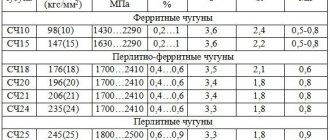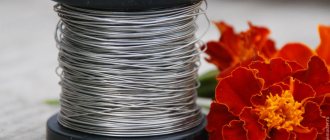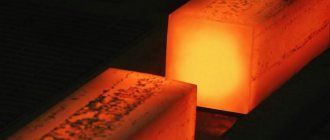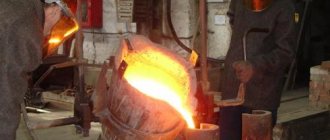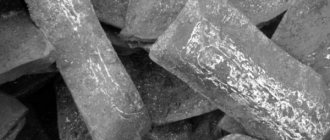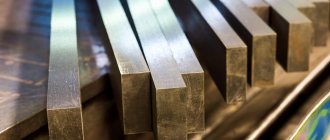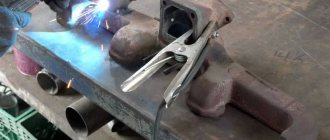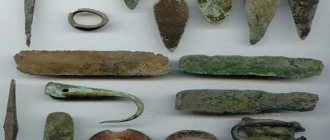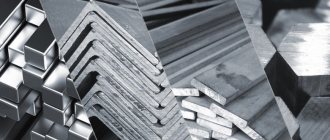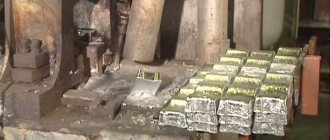Chemical composition of cast iron
Cast iron is an alloy of iron and carbon, in which the percentage of carbon is not less than 2.14% but not more than 4.5%. Carbon is part of cast iron in the form of cementite or graphite. If the percentage of carbon content is less than 2.14%, the alloy is called steel.
It is known that cast iron alloy was first produced in China in the 6th century. The secret of its production came to Europe in the 14th century, and in Russia its composition was brought to perfection only in the 17th century. Over all this long time, the formula of cast iron has not changed.
The highest quality material was produced at the Demidov brothers foundry, located in the Urals.
Over the centuries, it not only has not lost its relevance, but has also acquired an even wider range of applications.
Where is cast iron used | Metall
23/01/2015
Cast iron products have been known to a wide circle since ancient times and therefore, in our time, it is difficult to meet a person who does not know, have not heard of or have not encountered this alloy in his life. It is everywhere and everywhere - its application is so widespread. Cast iron is an iron alloy with a low carbon content, into which various additives are introduced, which greatly improves its quality.
Advantages of cast iron
The obvious superiority of cast iron compared to other metals can be assessed based on its area of application, quality characteristics, casting properties and value. This is a truly leading alloy in its segment and has undeniable advantages:
- 1. Large-scale application.
- 2.Availability and low price.
- 3.Excellent casting properties.
- 4.Highest strength and hardness.
- 5.Good malleability.
- 6.Durability.
Application area
Most of all, cast iron is used in heavy industry, metallurgy, machine tool building and mechanical engineering. The volumes of its use in these industries are enormous, from very small products to simply huge and heavy ones.
This is the production of massive bases for machine tools, various blocks, shafts, heads, bushings - for engines, both gasoline and diesel. The pipe rolling industry produces pipes of very high quality and durability, from very small sizes to large diameter pipes.
A lot of products are made from cast iron for household needs, which most people encounter every day in everyday life. Essential goods, as they can be called. These include various taps, valves, fittings, radiators and pipelines.
Some people still use cast iron sinks, sinks and bathtubs and give preference to them, despite the large selection of these products from other materials.
Another good quality of cast iron is its malleability. Professional blacksmiths consider it the best metal for these qualities. They make fences, fences, various bas-reliefs, edged weapons, and miniatures from it. Many of their products are not only beautiful and attractive, but also represent real masterpieces of art.
Another use of cast iron is casting. It can also be classified as art, which is what it actually is. There are also many beautiful works here that deserve attention and are works of art.
No matter how good this metal is, it still has one important flaw that comes from its hardness. This is fragility. Even one blow is enough, not strong, but sharp, and the cast iron cracks or falls into small pieces.
Types of material
There are such types of cast iron as limit and foundry. The first is used in the production of steel using the oxygen-converter route. Silicon and manganese are contained in very small quantities in this alloy. The casting type of material is more widely used in industry and manufacturing. It, in turn, is divided into the following types:
- White cast iron - the carbon in it is iron carbide. At the same time, a white tint is visible on its fault, which is where its name comes from. It is not used in its pure form. Used in the production of malleable cast iron.
- Gray cast iron is characterized by a silvery tint at the fracture. It has a wide range of applications and can be easily processed using cutters.
- A high-strength alloy is used to increase the strength characteristics of the manufactured material. It is obtained from gray cast iron by adding magnesium to its mass.
- Malleable cast iron is also a variety of gray cast iron. Its name indicates that it has increased ductility, and it is obtained from white cast iron by annealing.
- Half - has special properties. Part of the carbon in its composition is in the form of graphite, the rest is in the form of cementite.
Is titanium a non-ferrous or ferrous metal?
Titanium is used in the production of high-strength and heat-resistant alloys, and also as an alloying additive to carbon steel grades. In titanium alloys, the titanium content ranges from 85 to 99.5%. The main additives in them are aluminum, vanadium, molybdenum, manganese, zirconium. Titanium is included in the group of light non-ferrous metals along with aluminum and other chemical elements.
Titanium-based alloys also unconditionally belong to non-ferrous metals. They are used for casting and production of a wide range of metal products: sheet metal, pipes, profiles, foil, forgings, stamped blanks, etc. Small additions of titanium to carbon steel give the alloys increased strength and other special properties.
Alloy features
The main feature of cast iron is hidden in the process of its manufacture. The fact is that for different types of this alloy the melting point reaches 1200ºC, while for steel it is 1500ºC. This factor is affected by too high a carbon content. Iron and carbon atoms do not have very close bonds with each other.
When smelting occurs, the carbon atoms cannot be completely embedded in the molecular lattice of the iron, causing the cast iron alloy to become brittle. In this regard, it is not used in the production of parts that will be constantly subject to load.
This material belongs to the ferrous metallurgy industry and its characteristics are similar to steel. Products made of cast iron and steel are widely used in everyday life, and it is entirely justified.
If we compare the characteristics of these metals, we can draw the following conclusions:
- The cost of steel products is higher than the cost of cast iron.
- Differences in color: cast iron is dark and matte, while steel is light and shiny.
- Steel is less susceptible to casting, but, unlike cast iron, it is easier to forge and weld.
- Steel has greater strength than cast iron alloy.
- Steel is heavier in weight.
- It has a lower carbon content than cast iron.
What are ferrous metals
The term “ferrous metals” refers to iron and alloys with it as the main component (steels, cast irons).
According to some classifications, ferrous metals include manganese, vanadium, and chromium. This is a raw material for the production of cast iron and steel.
The main ferrous alloys are cast iron, steel, ferroalloys. They make up 90% of the production volume of metallurgical enterprises. The rest is made up of non-ferrous metals.
Almost all metals (90+%) in demand by the economy belong to the “ferrous” segment.
The unofficial name of the ferrous metals segment is ferrous metal .
Advantages and disadvantages
This material, like any other, has its strengths and weaknesses.
The advantages of cast iron include the following factors:
- Sometimes it is even compared in terms of characteristics to steel, because certain types of it are characterized by increased strength.
- Retains temperature for a long time: when heated, heat is distributed evenly throughout it and remains unchanged for a long time.
- It is an environmentally friendly material, which is why it is often used in the manufacture of utensils in which food will be directly cooked.
- Does not react to acid-base environment.
- It is a durable material.
- The longer a product made from this material is used, the better its quality becomes.
- This material is absolutely harmless to the human body.
The disadvantages include the following factors:
- It can become rusty even if water is kept in it for a short time.
- It is a very expensive material, but despite this, it fully justifies itself. Quality, practicality and reliability are the main features of products made from this alloy.
- Gray cast iron is characterized by low ductility.
- White is very fragile and is most often melted down.
Cost of ferrous metal
Purchase conditions vary taking into account the above properties and features of the product. The price for scrap ferrous metals in our company is 13,500–15,500 rubles per ton. When calculating the amount of payments, the following are also taken into account:
- volume of scrap metal lot;
- type of products;
- safety of operational properties;
- presence of garbage, etc.
Carbon and alloy content have less impact on customer income. To achieve maximum profit, we recommend sorting scrap and removing non-metallic impurities from the total mass.
Characteristics and properties of cast iron
This metal alloy has the following properties:
- Physical properties: specific gravity, actual shrinkage, linear expansion coefficient. For example, the carbon content of cast iron directly affects its specific gravity.
- Thermal properties. Thermal conductivity is usually calculated using the displacement rule. For the solid state of a metal, the volumetric heat capacity is 1 cal/cm3*оС. If the metal is in a liquid state, then it is approximately equal to 1.5 cal/cm3*oC.
- Mechanical properties. It is noteworthy that these properties are influenced both by the base itself and by the shape and size of the graphite. Gray cast iron with a pearlite base is the most durable, and with a ferritic base it is the most ductile. The lamellar form of graphite is characterized by the maximum reduction in strength, while the spherical form has the minimum reduction.
- Hydrodynamic properties. The presence of manganese and sulfur in the composition affects the viscosity of the material. It also tends to increase when the temperature of the alloy passes the point at which solidification begins.
- Technological properties. This metal is characterized by excellent casting qualities, as well as resistance to wear and vibration.
- Chemical properties. As the electrode potential decreases, the structural components of the alloy are arranged in the following order: cementite - phosphide eutectic - ferrite.
The properties of the alloy are also influenced by special impurities:
- The addition of sulfur significantly reduces fluidity and reduces refractoriness.
- Phosphorus allows you to make products of various shapes, but at the same time reduces its strength.
- The addition of silicon reduces the melting point of the material and also significantly improves casting properties. Silicon content in different percentages makes it possible to obtain alloys of different colors: from ferritic to pure white.
- The presence of manganese in the alloy significantly increases the hardness and strength of the material, but at the same time its casting and technological qualities deteriorate.
- In addition to these impurities, the alloy may also contain other components. In this case, the materials are called alloyed. Most often, titanium, aluminum, chromium, copper and nickel are mixed with cast iron.
Is cast iron a ferrous or non-ferrous metal?
We remind you that the main difference between ferrous and non-ferrous metals is the presence or absence of magnetic properties. There are several grades of non-magnetic cast iron, for which nickel, manganese, silicon and chromium are used for alloying. The entire range of cast irons is divided into white, gray, malleable, high-strength and pig alloys. The absolute majority of them are cast irons with magnetic properties.
Cast iron is used in foundries, and only pig iron is used for subsequent steel smelting. Basically, cast iron is a ferrous metal, but non-magnetic alloys have a dual nature, which allows them to be classified as both groups of metals. By the way, some brands of alloy cast iron are also susceptible to corrosion under atmospheric influences.
Metal composition and structure
Cast iron as a structural material is represented by a metal cavity with graphite inclusions. Its main components are pearlite, ledeburite and plastic graphite. It is interesting that in different types of alloys these elements are present in different proportions or may be completely absent.
According to its structure, cast iron alloy is divided into the following varieties:
- Pearlitic.
- Ferritic.
- Ferritic-pearlitic.
In this case, graphite may be present in it in one of the following forms:
- Spherical: Graphite takes this shape when magnesium is added. It is usually characteristic of high-strength cast iron products.
- Ductile: graphite resembles the shape of petals (this is the form in which it is present in ordinary cast iron). This material is characterized by increased ductility.
- Flaky: This shape is produced by the annealing process of white cast iron. Graphite is found in flake form in malleable cast iron.
- Vermicular: Graphite in this form is present in gray cast iron. It was developed specifically to increase its plastic properties.
Marking of white cast iron
To mark white cast iron, letters of the Russian alphabet and numbers are used. If it contains impurities, then the marking begins with the letter “H”. The composition of the available alloying additives can be determined by the following letters P, PL, PF, PVK. They indicate the presence of silicon. If the resulting metal has increased wear resistance, then its marking will begin with the letter “I”, for example ICHH, ICH. For example, the presence of the designation “Ш” in the marking means that the alloy structure contains spherical graphite.
The numbers indicate the amount of additional substances present in white cast iron.
Brand CHN20D2ХШ is deciphered as follows. This is a heat-resistant high-alloy metal. It contains the following elements: nickel - 20%, copper - 2%, chromium - 1%. The remaining elements are iron, carbon, and spherical graphite.
Manufacturing technologies
As you know, cast iron is produced in special blast furnaces. The main raw material for its production is iron ore. The manufacturing process consists of the reduction of iron ore oxides and the resulting production of another material - cast iron. For its production, fuels such as coke, thermoanthracite, and natural gas are used.
To produce one ton of pig iron, about 550 kilograms of coke and approximately a ton of water are required. The volume of ore loaded into the furnace will depend on the iron content in it. As a rule, ore is used, which contains at least 70% iron. The thing is that it is not economically feasible to use a lower concentration.
The first stage in the production of cast iron is its smelting. Ore is poured into the blast furnace, and then coking coal, which is necessary to pump and maintain the required temperature inside the furnace shaft. During combustion, these components take an active part in the ongoing chemical reactions as iron reducers.
Meanwhile, flux is immersed in the furnace, which acts as a catalyst. By accelerating the melting of rocks, it thereby supports the rapid release of iron. It is important to know that before loading into the furnace, the ore undergoes the necessary pre-treatment. It is crushed in a crushing plant because smaller particles melt faster. It is then washed to remove non-metal particles. Next, the raw material is fired, as a result of which sulfur and other foreign components are extracted from it.
At the second stage of production, natural gas is supplied through special burners into the filled and ready-to-use furnace. Coke is involved in heating the raw materials. Carbon is released, which combines with oxygen to form an oxide. It, in turn, promotes the recovery of iron from ore.
As the volume of gas in the furnace increases, the rate of the chemical reaction decreases. It may even stop completely when a certain gas ratio is reached. Carbon penetrates the alloy and combines with iron to form cast iron. Unmelted elements remain on the surface and are soon removed. Such waste is called slag. It is used to make other materials.
Lesson in the discipline “Materials Science” on the topic “Cast Irons”
Lesson topic: Cast iron
Lesson type
: A lesson in learning new material.
Lesson type
: Lecture.
Lesson equipment
: textbook, computer, multimedia projector.
Lesson objectives:
- educational:
study the classification of cast irons and the influence of carbon and impurities on the quality and properties of cast irons; - developing:
develop the ability to highlight the main thing and write it down in the form of a summary, be able to independently assimilate knowledge; develop creative thinking and attention; - educational:
to cultivate a culture of communication, a sense of collectivism and empathy for the successes and failures of comrades, the ability to work in a team, and to develop the technical literacy of students.
During the lesson, students develop basic general and professional competencies that meet the requirements of the Federal State Educational Standard for Secondary Professional Education in the specialty 02.23.03 “Maintenance and repair of motor vehicles”:
1. General competencies:
- the ability to understand the essence and social significance of one’s future profession, to show a sustained interest in it (GC 1);
- the ability to organize one’s own activities, choose standard methods and ways of performing professional tasks, evaluate their effectiveness and quality (OK 2);
- the ability to search for and use information necessary for the effective performance of professional tasks, professional and personal development (OC 4);
2. Professional competencies:
- the ability to develop measures for the integrated use of raw materials, to replace scarce materials and to find ways to dispose of production waste (PC 1.3).
During the classes
1. Organizational moment -3 min.
Greeting the teacher, checking readiness for the lesson, organizing attention.
2. Updating basic knowledge - 5 min.
During the frontal conversation, students are reminded of the basic concepts of the previous topic and asked the following questions:
- Tell us about the classification of steels.
- What permanent impurities are contained in steels?
- What is cast iron?
3. Formulation of the topic and objectives of the lesson.
Subject:
Cast iron.
Target:
at the end of the lesson, students should know the classification of cast iron and markings according to GOST, and be able to decipher the grades of cast iron.
4. Explanation of new material.
5. Consolidation of new material.
Questions for consolidation
- Tell us about the classification of cast iron.
- For the manufacture of which parts are white and gray cast iron used?
- What parts are made from high-strength and ductile cast iron?
- How are ductile and ductile cast irons designated?
6. Homework.
Lecture notes, make a table “Cast irons”
Recommended theoretical material
- Classification of cast irons
- White cast iron. Its structure, properties, application
- Gray cast iron, its structure, properties, marking according to GOST and application
- Malleable iron
- Ductile iron
- Anti-friction cast irons, marking, and application
1. Classification of cast irons
Cast iron is a multicomponent alloy of iron with carbon, manganese, silicon, phosphorus and sulfur. Cast iron also contains trace amounts of hydrogen, nitrogen and oxygen. Alloyed cast iron can contain chromium, nickel, vanadium, tungsten and titanium, the amount of which depends on the composition of the ores being smelted.
Depending on their purpose, cast iron smelted in blast furnaces is divided into three main types: pig iron, which is used for conversion into steel; foundry, intended for producing cast iron castings in mechanical engineering; blast furnace ferroalloys used for steel deoxidation in steelmaking.
According to their structure, cast iron can be divided into the following groups:
- gray - cast iron, in which carbon is in the form of graphite.
- white - cast iron in which carbon is in the form of cementite and perlite.
According to their purpose, cast iron can be classified as follows:
- Malleable
- Heat resistant
- High strength
- Anti-friction.
2. White cast iron. Its structure, properties, application
Cast iron received this name from the type of fracture, which has a matte white color.
White cast iron (pipe cast iron) is rarely used in the national economy as structural materials, since due to the high content of cementite, it is very brittle and hard and difficult to cast and process with tools. They are used to make parts of hydraulic machines, sand blowers and other structures that operate under conditions of increased abrasive wear. White cast iron is used for the manufacture of parts with increased fatigue strength: crankshafts and camshafts, valve seats, oil pump gears, VAZ disc brake calipers, etc. To increase wear resistance, white cast iron is alloyed with chromium, vanadium, molybdenum and other carbide-forming elements. The marking of white cast iron is not established.
A variety of white cast iron is bleached cast iron. The surface layers of products made from such cast iron have the structure of white (or half-cast) cast iron, and the core is of gray cast iron. Chilling to a certain depth (12...30 mm) is obtained by rapidly cooling the surface (for example, casting cast iron into metal or sand molds).
To relieve structural stresses that can lead to cracks, castings are heated. The high wear resistance of bleached cast iron is due to the hardness of the surface. Rolls of sheet mills, wheels, balls for mills, etc. are made from bleached cast iron.
3. Gray cast iron, its structure, properties, marking according to GOST and application
The structure of gray (casting) cast iron consists of a metal base with plate-shaped graphite embedded in this base. Such a structure is formed directly during the crystallization of cast iron in a casting in accordance with the state diagram of the Fe-C (stable) system. Moreover, the more carbon and silicon in the alloy and the lower the cooling rate, the higher the probability of crystallization according to this diagram with the formation of graphite eutectic. With low carbon and silicon content, cast iron is modified with small doses of certain elements (for example, aluminum, calcium, cerium).
Modification of metals is the introduction of modifiers into metal melts, that is, substances, small quantities of which (usually no more than tenths of a percent) contribute to the creation of additional artificial crystallization centers, and consequently, the formation of structural components in crushed or rounded form, which improves the mechanical properties of the metal.
To characterize the structure of gray cast iron, it is necessary to determine the size, shape, distribution of graphite, as well as the structure of the metal base. In ordinary gray cast iron, when cooled slowly during crystallization, the graphite branches very little. It looks like a rosette with a small number of curved petals.
The metal base of gray cast irons is formed from austenite during eutectoid decomposition and can be pearlitic, ferritic and ferritic-pearlitic. The formation of perlite occurs easily, in a relatively short period of time.
The mechanical properties of gray cast iron depend on the properties of the metal base and, mainly, on the number, shape and size of graphite inclusions. The pearlite base provides the highest values of strength and wear resistance.
Grades of gray cast iron according to GOST 1412 - 85 consist of the letters “СЧ” and numbers corresponding to the minimum tensile strength. Cast iron SCh15 - ferritic; SCh25, SCh30, SCh35 are ferritic-pearlitic cast irons, starting from SCh40 - pearlitic cast irons.
Gray cast irons have high casting properties (fluidity, low shrinkage, slight burning of metal to the mold, etc.), are well processed and resist wear, however, due to low strength and plastic properties, they are mainly used for non-critical parts. In machine tool industry, gray cast iron is the main structural material (machine beds, tables and upper slides, columns, carriages, etc.); in the automotive industry, crankcases, covers, brake drums, etc. are made from ferritic-pearlite cast iron, and cylinder blocks, liners, flywheels, etc. are made from pearlitic cast iron. In construction, gray cast iron is used mainly for the manufacture of parts that operate under compression (shoes , columns), as well as sanitary parts (heating radiators, pipes). A significant amount of cast iron is used to make tubes from which the subway tunnel is constructed.
4. Ductile iron
Malleable cast iron is called malleable because it can be subjected to pressure treatment, although cast iron is not forged, and cast iron parts are produced only by casting due to the fact that malleable cast iron has higher ductility compared to gray cast iron.
Malleable cast irons with flake graphite are produced from white hypoeutectic cast irons by subjecting them to special graphitizing annealing. Graphitizing annealing of white cast iron is based on the metastability of cementite and usually consists of two stages (figure)
Drawing. Scheme of annealing white cast iron into malleable
The first stage (930...1050°C) is selected for a duration such that all the cementite in the casting structure disintegrates into austenite and flake graphite. The process of graphite formation is facilitated by modification (for example, aluminum and boron). Cast iron obtained in this way is called modified.
At the second stage of graphitizing annealing at the temperature of the eutectoid transformation, the metal base of malleable cast iron is formed. Depending on the cooling modes, malleable cast irons can have pearlitic (continuous cooling), ferritic (very slow cooling in the range of 700...760°C) or ferritic-pearlitic (reduced duration of the second annealing stage) metal base. To obtain a pearlite base in modified ductile iron, it is recommended to increase the content of manganese, chromium and some other elements, which increase the resistance of cementite to decomposition into ferrite and lamellar graphite in the eutectoid transformation temperature range.
Malleable cast irons with a pearlitic metal base have high hardness and strength combined with low ductility. Malleable ferritic cast iron is characterized by high ductility and relatively low strength.
Malleable cast iron according to GOST 1215 - 79 is marked with the letters “KCH” and two numbers: the first indicates tensile strength; the second is relative elongation (%).
Malleable cast iron is used for the manufacture of parts with increased strength and toughness: crankcases, gearboxes, gearboxes, spring brackets, etc.
5. Ductile iron
High-strength cast iron - cast iron with nodular graphite, is obtained by modifying with liquid additives magnesium from the mass of the processed portion of cast iron, cerium, yttrium and some other elements. In this case, before introducing modifiers, it is necessary to reduce the sulfur content.
To avoid the formation of ledeburite in high-strength cast irons, they are subjected to graphitizing annealing. Due to the increased content of graphitizing elements (carbon, silicon), the duration of such annealing is much shorter than when annealing white cast iron.
The structure of high-strength cast iron consists of a metal base (ferrite, pearlite) and spherical graphite inclusions. Spherical graphite, which has a minimal surface area for a given volume, weakens the metal base significantly less than flake graphite and is not an active stress raiser.
Grades of high-strength cast iron according to GOST 7293-85 consist of the letters “HF” and numbers, the former indicate the value of tensile strength, the latter - relative elongation (%). The standard provides for the following grades of cast iron: VCh35-22; VCh40-15; HF45-10; VC50-7; HF60-3; VC70-2; HF80-2; HF100-2.
High-strength cast irons have good casting and consumer properties (cutting machinability, ability to dampen vibrations, high wear resistance, etc.). They are used for massive castings to replace steel cast and forged parts - cylinders, gears, crankshafts and camshafts, etc.
6. Anti-friction cast irons, marking, and application
Anti-friction cast irons are gray and high-strength cast irons of special grades.
Antifriction gray cast irons - pearlitic cast iron AChS-1 and AChS-2 and pearlitic-ferritic cast iron AChS-3. These cast irons have a low coefficient of friction, depending on the ratio of ferrite and pearlite in the base, as well as the amount and form of graphite. In pearlitic cast irons, high wear resistance is ensured by a metal base consisting of thin pearlite and uniformly distributed phosphorus eutectic in the presence of isolated deposits of lamellar graphite.
Anti-friction gray cast iron is used for the manufacture of sliding bearings, bushings and other parts that operate under friction with metal, often in the presence of a lubricant. Parts working in tandem with hardened or normalized steel shafts are made from AChS-1 and AChS-2 cast iron, and for work in tandem with thermally untreated shafts, AChS-3 cast iron is used.
Anti-friction high-strength (with nodular graphite) cast irons are made with a pearlite structure - AChV-1 and ferrite-pearlite (50% pearlite) - AChV-2. AChV-1 cast iron is used to work in friction units with increased peripheral speeds in conjunction with a hardened or normalized shaft.
The main advantage of anti-friction cast irons compared to babbitts and anti-friction bronzes is their low cost, and the main disadvantage is poor run-in, which requires precise mating of the rubbing surfaces.
Marking of cast iron is carried out by a combination of letters and numbers.
The following notations are accepted:
Example: ASF1; ASF2; ASF3; AChV1; AChV2; ABC1; ABC2.
The letters "ACS" indicate anti-friction gray cast iron; “AChV” - Anti-friction high-strength cast iron; "AChK" - anti-friction malleable cast iron.
Bibliography
- Kolesnik P. A. Materials science in automotive transport: a textbook for students. higher textbook institutions / P. A. Kolesnik, V. S. Klanitsa. — 2nd ed., erased. - M.: Publishing House, 2007. - 320 p.
- Rogacheva L.V. Materials Science.- M.: Kolos-Press, 2002.- 136 p.: ill. (Textbooks and teaching aids for secondary vocational education).
- Stukanov V.A. Materials science: textbook - M.: Publishing House "Forum": INFRA - M, 2008. - 368 pp.: ill. - (Professional education)
- GOST 1412-85 Cast iron with flake graphite for castings. Stamps
- GOST 1585-85 Anti-friction cast iron for castings. Stamps
- GOST 7769-82 Alloyed cast iron for castings with special properties. Stamps
